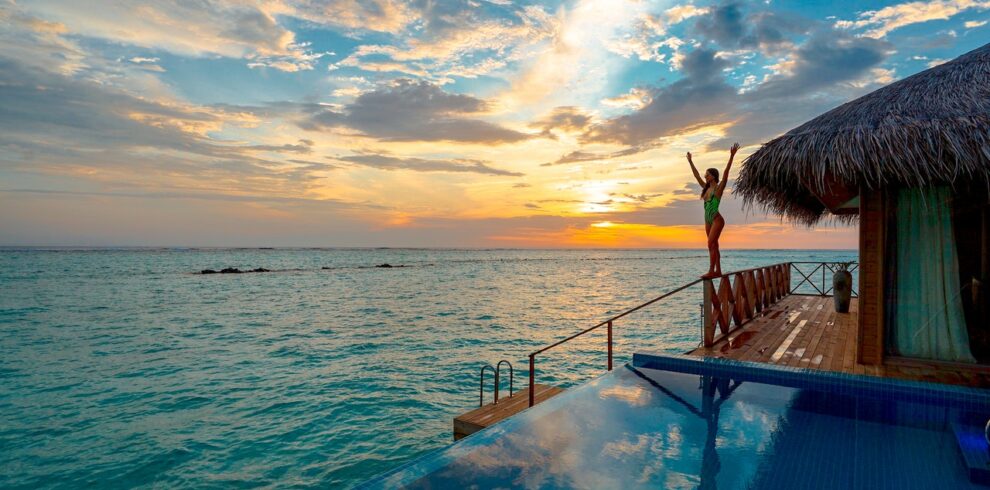Maldives
The Maldives with its tourism tagline “Always Natural” is the most celebrated group of islands in the Indian Ocean and perhaps the world over. The stunning beauty of its turquoise lagoons and pristine beaches is simply unrivalled. The Maldives islands are one of the few places on earth that everyone hopes to experience in their lifetime—and once you see it, you are forever enamored. However, the Maldives is more than just a tourist paradise. It is referred to as “Dhivehi Raajje” by the indigenous people meaning the country of the Dhivehi people.
The Maldives Ecology:
The Maldives Islands boast of a vibrant and diverse ecosystem that is comprised of 21 dolphin and whale species, 400 molluscs species, 83 echinoderm species and an incredible 1,100 fish species. The country is also globally known for its vast coral colonies with a pulsating undersea life that attracts tourists from far and wide.
Maldives Location & Geography:
The Maldives is a collection of 1,192 coral islands located in the Indian Ocean close to the Indian subcontinent. The Maldivian archipelago comprises of 26 natural coral atolls – a chain of islands formed from coral reefs, that grew around a submerged volcanic mountain. The country is home to 300,000 people who live on 192 islands. Most of the remaining islands are left untouched for the ecosystem to flourish. Close to 100 islands have been transformed into tourism hubs that form the backbone of the Maldivian economy. Until the 1970s, the Maldives was relatively unknown to the world. With the tourism boom on island resorts, the Maldives has become the tropical paradise for holidaymakers.
Maldives Religion & Customs:
The first settlers of the Maldives were from southern India and Sri Lanka which is evident even today in culture, customs and language of Maldives. The official language of the Maldives is Dhivehi, which carries intonations of Sinhalese. The people of Maldives were Buddhist for a long period of time. They later became an Islamic nation in the 12th century after Middle eastern traders brought Sunni Islam to the archipelago.
Maldives Climate:
Summary
Maldives has a tropical climate which is warm and sunny throughout the year with very little variations in temperature. Tourist peak season in the Maldives is from December to April when there is very little rainfall and low humidity. Generally the temperature varies between 26-32C with the hottest month in April. The weather cools somewhat in December.
Monsoons
The year is divided into two seasons based on the monsoons. The North East monsoon (Iruvai) period lasts from December – April when there is very little rainfall, lower humidity, calm seas and constant sunshine. This is the tourist peak season and visitors escape to the island resorts for their beach holiday. High humidity and heavy rainfall occurs during the wet season is from May – October with the onset of the South West monsoon (Hulhangu). The seas are rougher during this time with potential for strong winds. The Maldives is located south west of Sri Lanka on the equator and is affected by climatic changes including cyclones in the Bay of Bengal and the Arabian Sea.
Scuba diving & surfing seasons
Scuba diving in the Maldives is generally good all year around but underwater visibility, water temperatures and marine life changes depending on the season. During the dry season (December – April) underwater diving is most rewarding on the eastern side of an atoll, while during the rainy season (May – October), the Western side of an atoll is better for scuba diving. Make sure you select your resort accommodation accordingly.
Surfing is best from March – October during the off season when the wave brakes are better. Hotel rates are cheaper during this time making a surfing trip to the Maldives more affordable.
Visa for Indian Citizens:
The Maldives government issues three different type of visas for foreign nationals visiting the country. These are the tourist visa, business visa and family/friend visit visa.
Types of Visa
Tourist visa: If a person is travelling to Maldives for the purpose of tourism then he or she needs to apply for a tourist visa which is free of cost and valid for single entry. The Maldives government issues a visa on arrival to nationals of all countries which are a valid for a period of 30 days can be extended to 60 days.
The documents required for getting a visa on arrival are:
• The passport should not expire for at least 6 months from the date of the travel.
• 2 recent colour photograph (3.5×4.5cm) on a white background.
• The visitor should have an air ticket to fly out of Maldives
• Accommodation proof (hotel reservation or invitation letter if visiting someone in Maldives).
• The visitor should have enough money for the duration of his or her stay in the country.

